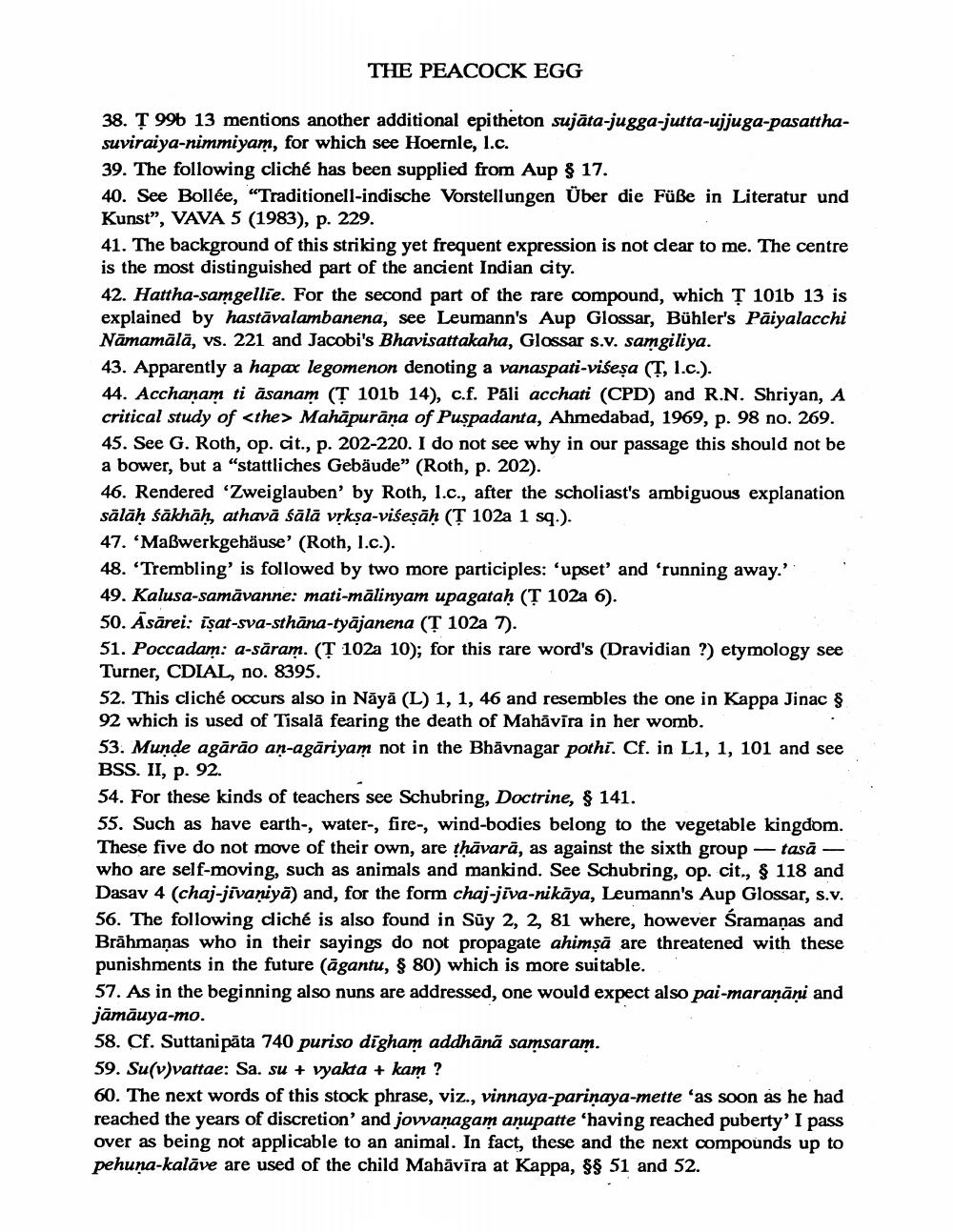________________
THE PEACOCK EGG
38. Ț 996 13 mentions another additional epitheton sujāta-jugga-jutta-ujjuga-pasatthasuviraiya-nimmiyam, for which see Hoernle, 1.c. 39. The following cliché has been supplied from Aup $ 17. 40. See Bollée, "Traditionell-indische Vorstellungen Über die Füße in Literatur und Kunst”, VAVA 5 (1983), p. 229. 41. The background of this striking yet frequent expression is not clear to me. The centre is the most distinguished part of the ancient Indian city. 42. Hattha-samgellie. For the second part of the rare compound, which Ț 1016 13 is explained by hastāvalambanena, see Leumann's Aup Glossar, Bühler's Paiyalacchi Nāmamālā, vs. 221 and Jacobi's Bhavisattakaha, Glossar s.v. samgiliya. 43. Apparently a hapax legomenon denoting a vanaspati-vićeşa (T, 1.c.). 44. Acchanam ti asanam (T 1016 14), c.f. Páli acchati (CPD) and R.N. Shriyan, A critical study of <the> Mahāpurāna of Puspadanta, Ahmedabad, 1969, p. 98 no. 269. 45. See G. Roth, op. cit., p. 202-220. I do not see why in our passage this should not be a bower, but a "stattliches Gebäude” (Roth, p. 202). 46. Rendered 'Zweiglauben' by Roth, 1.c., after the scholiast's ambiguous explanation sälāḥ śākhāh, athavā śālā vrkşa-viśeşāḥ (T 102a 1 sq.). 47. 'Maßwerkgehäuse' (Roth, 1.c.). 48. 'Trembling' is followed by two more participles: 'upset' and 'running away.' 49. Kalusa-samāvanne: mati-mālinyam upagataḥ (T 102a 6). 50. Asārei: işat-sva-sthāna-tyājanena (T 102a 7). 51. Poccadam: a-sāram. (T 102a 10); for this rare word's (Dravidian ?) etymology see Turner, CDIAL, no. 8395. 52. This cliché occurs also in Nāyā (L) 1, 1, 46 and resembles the one in Kappa Jinac $ 92 which is used of Tisalā fearing the death of Mahāvīra in her womb. 53. Munde agārāo an-agāriyam not in the Bhavnagar pothi. Cf. in L1, 1, 101 and see BSS. II, p. 92. 54. For these kinds of teachers see Schubring, Doctrine, $ 141. 55. Such as have earth-, water-, fire-, wind-bodies belong to the vegetable kingdom. These five do not move of their own, are thāvarā, as against the sixth group — tasā — who are self-moving, such as animals and mankind. See Schubring, op. cit., § 118 and Dasav 4 (chaj-jivaniyā) and, for the form chaj-jiva-nikāya, Leumann's Aup Glossar, s.v. 56. The following cliché is also found in Sūy 2, 2, 81 where, however Śramaņas and Brāhmaṇas who in their sayings do not propagate ahimşā are threatened with these punishments in the future (āgantu, $ 80) which is more suitable. 57. As in the beginning also nuns are addressed, one would expect also pai-maraņāņi and jāmāuya-mo. 58. Cf. Suttani pāta 740 puriso dīgham addhānā samsaram. 59. Su(v)vattae: Sa. su + vyakta + kam? 60. The next words of this stock phrase, viz., vinnaya-pariņaya-mette ‘as soon as he had reached the years of discretion' and jovvanagam anupatte 'having reached puberty' I pass over as being not applicable to an animal. In fact, these and the next compounds up to pehuņa-kalāve are used of the child Mahāvīra at Kappa, 88 51 and 52.




